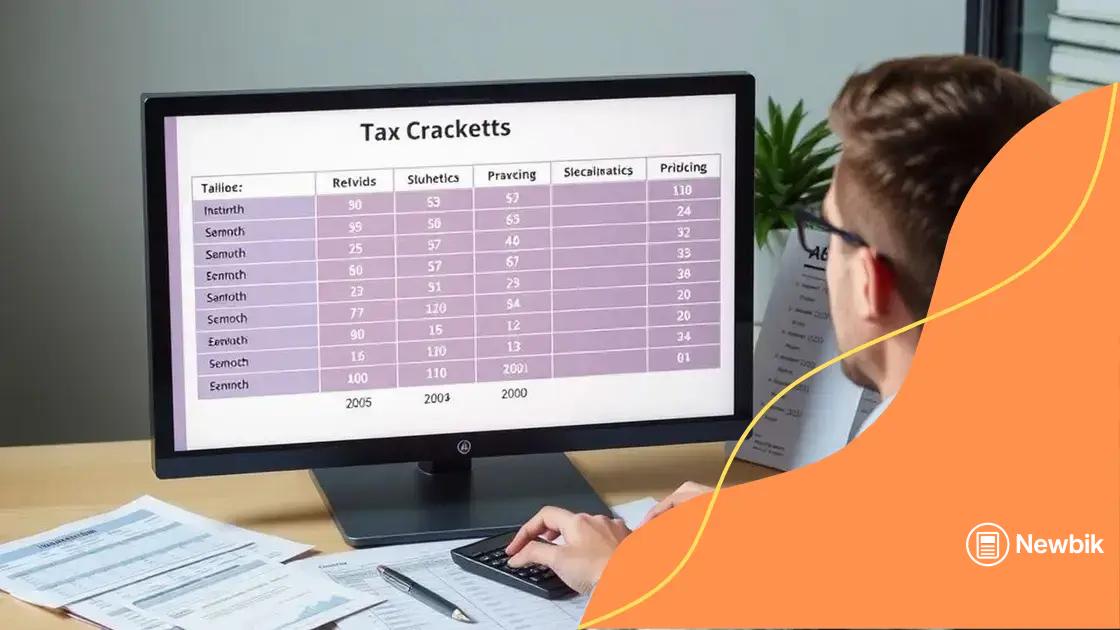Tax bracket calculator: understand your potential savings

A tax bracket calculator helps determine your tax obligations by identifying which income ranges are taxed at specific rates, allowing for effective financial planning and maximizing tax savings.
Tax bracket calculator tools are essential for anyone looking to navigate the complexities of tax planning. Have you ever wondered how much you could save just by understanding your tax position? Let’s dive into how these calculators work and their importance in effective financial planning.
What is a tax bracket calculator?
A tax bracket calculator is a useful tool that helps individuals understand their potential tax liabilities. By inputting your income and filing status, you can see which tax bracket you fall into. This information is vital because it influences how much of your income is taxed at different rates.
Tax brackets often change with each tax year, so it’s essential to keep up-to-date. A calculator can give insights into how changes in your income might affect your tax situation. Additionally, knowing your tax bracket can help you make informed decisions about deductions and credits.
How does a tax bracket work?
Tax brackets are structured in tiers. As your income increases, the rates on incremental amounts also rise. For example, if you’re in a lower tax bracket, only the income within that range is taxed at the lower rate.
- The first portion of your income is taxed at the lowest rate.
- Your next income tier is taxed at the next higher rate.
- This continues until your entire income is taxed based on the brackets you fall within.
This progressive system means that as you earn more, only the income above the threshold of the previous bracket gets taxed at the higher rate. Understanding this system allows you to better plan your finances.
Moreover, a tax bracket calculator provides a clearer picture by showing your effective tax rate. This is the average rate you pay on your total income, which can differ significantly from the highest rate in your bracket.
Benefits of using a tax bracket calculator
Using a tax bracket calculator can have various advantages:
- It clarifies your tax obligations, reducing uncertainty.
- You can identify potential savings from deductions or credits.
- Planning becomes easier, especially during tax season.
In conclusion, a tax bracket calculator serves as a valuable resource for anyone navigating the complexities of taxation. By understanding your bracket and how it works, you can make more informed financial decisions.
How to use a tax bracket calculator effectively
Using a tax bracket calculator effectively can simplify your tax planning process significantly. The first step is to gather all necessary financial information. This includes your income sources, filing status, and any potential deductions or credits.
Once you have your information ready, input it into the calculator. Most calculators will require you to enter your total income. Make sure you add all sources, including wages, bonuses, and investment income. Accuracy is crucial here.
Inputting your information
When entering your data, it’s essential to be thorough and precise. Here are a few tips:
- Use your most recent tax return as a reference.
- Consider any changes in income that might affect your bracket.
- Do not forget about deductible expenses that can reduce your taxable income.
As you proceed, the calculator will display your estimated tax obligations based on the entered data. This visualization helps you understand where you stand and how much you might owe or expect as a refund.
By adjusting the input variables, you can see how different scenarios affect your tax bracket. For example, add a bonus or an additional source of income to evaluate its impact on your taxes. This feature allows for strategic planning, helping you make informed choices throughout the year.
Reviewing the results
After crunching the numbers, take time to review your results. The calculator not only displays your tax bracket but often provides your effective tax rate. Understanding these figures is vital to making smart financial decisions.
- Note how much of your income is taxed at different rates.
- Identify areas where you might save, such as specific deductions.
- Review your overall tax liability to adjust your withholdings if needed.
Additionally, many tax calculators provide valuable resources for further reading. These can help you understand tax laws and potential changes. Staying informed will empower you to manage your taxes proactively.
Understanding different tax brackets

Understanding different tax brackets is essential for anyone filing their taxes. Tax brackets determine how much tax you pay based on your income level. Essentially, your income is divided into segments, each taxed at different rates.
As your income grows, you may move into higher tax brackets. This does not mean that all your income is taxed at the higher rate. Instead, only the income that exceeds a certain threshold is taxed at that steep rate. For example, the first part of your income may be taxed at a lower rate, while any income above that bracket is subject to higher rates.
How tax brackets are structured
Tax brackets often follow a progressive system, meaning that they increase as income rises. Here’s a simple breakdown:
- The initial portion of your income is taxed at the lowest rate.
- As you earn more, additional income is taxed at higher rates.
- This structure helps ensure that those with higher earnings contribute a fairer share.
This tiered system is designed to alleviate the financial burden on lower earners while ensuring that those who can afford to pay more do so. Knowing where you stand in this system is key to effective financial planning.
Impact of tax brackets on your finances
Understanding how tax brackets work can significantly impact your financial decisions. When you know which bracket you are in, you can adjust your income strategies accordingly. For instance, you might choose to defer income to a later year if you expect to be in a lower tax bracket in the future.
Additionally, tax planning becomes easier when you are aware of the brackets. You may decide to take advantage of deductions that lower your taxable income, effectively reducing the burden of higher brackets. This knowledge allows you to make more informed financial choices, from retirement savings to investments.
Common misconceptions about tax brackets
There are several common misconceptions about tax brackets that can lead to confusion during tax season. Many individuals misunderstand how tax brackets work, often thinking that their entire income is taxed at the highest rate applicable to their earnings. This is simply not the case.
In reality, tax brackets are structured to ensure that only the income exceeding a specific threshold is taxed at the higher rates. For example, if you earn a salary that places you in a higher bracket, only the portion of your salary that exceeds that bracket threshold is taxed at that higher rate.
Tax brackets do not define your total tax rate
Another prevalent myth is that tax brackets define an individual’s average tax rate. This is misleading. The average tax rate is the total tax paid divided by total income, and it can be significantly lower than the marginal tax rate, which applies to the last dollar earned. Understanding this difference can help taxpayers better assess their financial situation.
- Marginal tax rate applies to income within a specific bracket.
- Average tax rate reflects the overall percentage of income paid in taxes.
- Being in a higher tax bracket doesn’t mean all income is taxed at that rate.
Furthermore, some people believe that tax deductions do not play a role in how much tax they owe. This is incorrect. Deductions can lower your taxable income, which may move you into a lower tax bracket, reducing your overall tax liability. Proper use of deductions can help you save money on your taxes.
Tax brackets only affect rich people
There’s also a misconception that tax brackets primarily affect wealthier individuals. In truth, tax brackets apply to everyone, regardless of income level. Even those in lower brackets benefit from understanding their tax situation and how it may change with different income levels.
Being aware of these common misconceptions helps individuals make informed decisions about their finances. Tax brackets may seem complicated, but grasping their basics can enhance your overall financial strategy.
Tips for maximizing tax savings
Maximizing your tax savings requires careful planning and awareness of available options. Even small adjustments can lead to considerable savings when it comes time to file your taxes. One of the first steps is to keep detailed records of all your income and expenses throughout the year. This will make it easier to assess your financial situation and identify potential deductions.
Utilizing tax-advantaged accounts can also play a significant role in saving money. For instance, contributing to a retirement account like a 401(k) or an IRA can lower your taxable income. Additionally, funds in these accounts often grow tax-free until you withdraw them in retirement.
Take advantage of deductions and credits
Understanding the available deductions and credits is crucial for effective tax planning. Here are some tips:
- Keep track of medical expenses, as they may be deductible if they exceed a certain percentage of your income.
- Consider itemizing deductions instead of taking the standard deduction, especially if you have significant expenses.
- Look into credits for education, home energy improvements, or child care, as these can provide direct reductions to your tax bill.
Moreover, contributing to charitable organizations can provide additional deductions. Ensure you have proper documentation for any donations made, as this can further enhance your tax savings. By being proactive and keeping detailed records, you can identify opportunities to maximize your deductions.
Plan for the future
Another strategy to consider is tax loss harvesting. This involves selling loss-making investments to offset gains in others. By strategically managing your investment portfolio, you can mitigate tax liabilities while potentially improving returns.
Lastly, consider consulting with a tax professional. They can guide you through specific strategies tailored to your financial situation and help ensure you’re making the most of available savings. Working with an expert is often worthwhile, especially as tax laws change frequently.
FAQ – Common Questions About Tax Brackets and Savings
What are tax brackets?
Tax brackets are ranges of income that are taxed at specific rates. As your income increases, the rate of tax you pay on that income may also rise.
How can I maximize my tax savings?
You can maximize tax savings by utilizing deductions and credits, contributing to retirement accounts, and keeping detailed records of your expenses.
Do deductions really make a difference?
Yes, deductions can significantly lower your taxable income, which may reduce the overall amount of tax you owe.
Should I consult a tax professional?
Yes, consulting a tax professional can provide personalized strategies to optimize your tax savings and ensure compliance with tax laws.